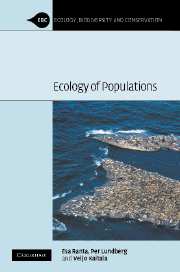Book contents
- Frontmatter
- Contents
- Preface
- 1 Introduction
- 2 Population renewal
- 3 Population dynamics in space – the first step
- 4 Synchronicity
- 5 Order–disorder in space and time
- 6 Structured populations
- 7 Biodiversity and community structure
- 8 Habitat loss
- 9 Population harvesting and management
- 10 Resource matching
- 11 Spatial games
- 12 Evolutionary population dynamics
- 13 Epilogue
- References
- Index
4 - Synchronicity
Published online by Cambridge University Press: 02 December 2009
- Frontmatter
- Contents
- Preface
- 1 Introduction
- 2 Population renewal
- 3 Population dynamics in space – the first step
- 4 Synchronicity
- 5 Order–disorder in space and time
- 6 Structured populations
- 7 Biodiversity and community structure
- 8 Habitat loss
- 9 Population harvesting and management
- 10 Resource matching
- 11 Spatial games
- 12 Evolutionary population dynamics
- 13 Epilogue
- References
- Index
Summary
Charles Elton (1924) was very well aware of the fact that many populations of a given species display large-scale temporal match in their population fluctuations. He was also among the first to propose that this, almost ubiquitous phenomenon, is due to environmental forcing, redistribution of individuals between breeding seasons, or biotic interactions of some kind. In this chapter, we shall first describe, with a set of examples familiar to us, patterns of synchronicity in various taxa. In these data, one new feature emerges that Elton did not mention: often the degree of coherent temporal population fluctuations is high among nearby populations but levels off with increasing distance. In the second part we shall address the question of how to analyze synchrony patterns. Finally we will turn to the different major explanations provided to understand large-scale synchronous fluctuations in population features of animals and plants.
Natural populations live in patchy environments. The distribution area of any given species should not be viewed as a continuous uniformly spread population, evenly painted over the landscape. Rather, the environment is composed of a network of habitable areas differing in profitability and of areas less suitable for population renewal. Even in pristine habitats, individuals are not distributed evenly all over the range. Our dogma is that natural populations are composed of local populations of varying size and quality. The independence of these units may vary: some of them can be entirely isolated while most population subunits are linked to other similar units via dispersing individuals.
- Type
- Chapter
- Information
- Ecology of Populations , pp. 66 - 97Publisher: Cambridge University PressPrint publication year: 2005



